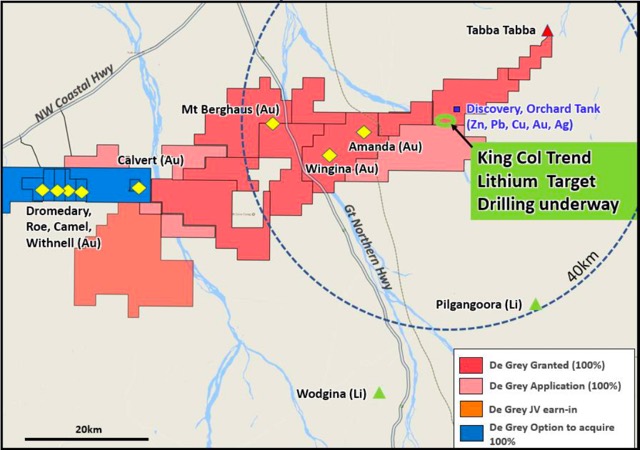De Grey Mining commences drilling of lithium targets near Pilgangoora and Wodgina

De Grey Mining (ASX: DEG) has commenced drilling today to test the defined 2km lithium-in-soil anomaly at the King Col Pegmatite.
Key Highlights:
- King Col is a 7.5km long pegmatite trend with potential to host a Wodgina or Pilgangoora style Lithium-Caesium-Tantalum deposit.
- 1,500m RC drilling program has commenced with rig on site.
- Co-funding by WA Government approved to $61,000 of direct drilling costs.
- Program will test initial 2km lithium-in-soil anomaly with a further 5.5kms requiring soil sampling.
- Large exploration target in proximity to world class Wodgina and Pilgangoora lithium deposits.
Co-funding has also been approved under the WA Government’s Exploration Incentive Scheme (EIS), which will contribute $61,000 to De Grey’s program, being approximately 50% of the direct drilling costs.
The company refers shareholders and potential investors to previous De Grey ASX releases where the sampling and potential of the King Col Pegmatite Trend has been highlighted:
- “Soil sampling defines coherent Li2O anomaly at King Col Pegmatite Trend” (1 December 2016); and
- “Li anomaly extended to 2km and remains open for 5kms to east” (16 January 2017).
King Col Pegmatite Trend Summary
The previous De Grey sampling at the King Col Pegmatite Trend has highlighted anomalous lithium and other associated elements for Lithium-Caesium-Tantalum (LCT) style mineralisation.
Reconnaissance rock chip sampling and subsequent follow-up systematic soil sampling has defined strong anomalies over an initial 2km strike length (Figure 1).
Further sampling is required to test the remaining 5.5km of the overall 7.5km long pegmatite trend.

Figure 1: King Col lithium-in-soil anomalies.
Earlier rock chip results highlight anomalous Lithium Oxide (Li2O) results ranging from 0.15% to 4.22%. Associated elements include Tantalum Pentoxide (Ta2O5) to 221.6ppm, Caesium (Cs) to 1605ppm, Niobium (Nb) to 146ppm, Rubidium (Rb) to 8420ppm (0.84%) and Beryllium (Be) to 23800ppm (2.38%).
Subsequent systematic soil sampling over an initial 2km strike length yielded encouraging elevated and robust linear lithium zones based on >108ppm Li2O threshold. Three discrete high-grade priority target zones occur within this broad 2km long anomaly which remains open to the east.
To the east the pegmatite trend is defined by limited and weathered pegmatite outcrops throughout the remaining 5.5kms.
Southern Zone: 1200m long, peak 943ppm Li2O
Central Zone: 1200m long, peak 344ppm Li2O
Eastern Zone: 800m long, peak 409ppm Li2O
The King Col pegmatite lies within De Grey’s 100% owned tenements, and is located within 40km from the world class Pilgangoora deposit and approximately 50km from the Wodgina deposit (Fig 2).
Pilgangoora deposit – Wodgina Resource:
156.3Mt @ 1.25% Li2O (Pilbara Minerals Limited) and
42.6Mt @ 0.99% Li2O (Altura Mining Limited)
120.8Mt @ 1.28% Li2O (Mineral Resources Limited)

Figure 2: King Col location plan.
Proposed Drilling Program
The drilling program will initially comprise approximately 1,500m of RC drilling as a series of drilling fences across the three main anomalous zones.
The drilling will test beneath the anomalous lithium-in-soil zones and determine mineralisation potential in fresh bedrock.
Subject to positive results a further program of diamond drilling will be undertaken to obtain fresh mineralisation in drill core for detailed mineralogical evaluation. This will aim to define the presence of spodumene in the pegmatite system.
Spodumene is the key lithium mineral in most lithium bearing pegmatite orebodies throughout the world.
Exploration Manager, Mr. Phil Tornatora, said:
“King Col is a large lithium target located in one of the best lithium provinces of Australia, close to Port Hedland and shipping facilities.
This drilling program will provide us with our first ever look at the rocks below the extensive soil anomalies.”
The RC drilling has commenced and is expected to take approximately 2 weeks to complete.
Results are expected during October.
